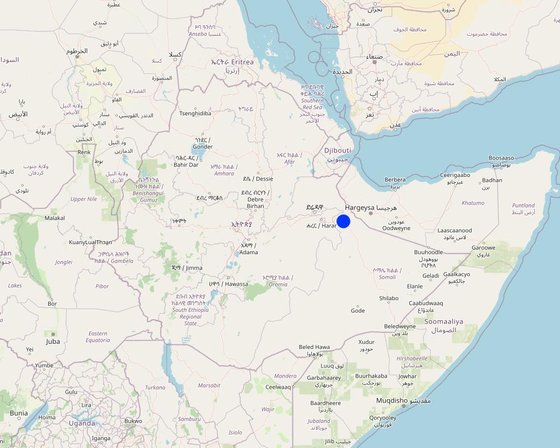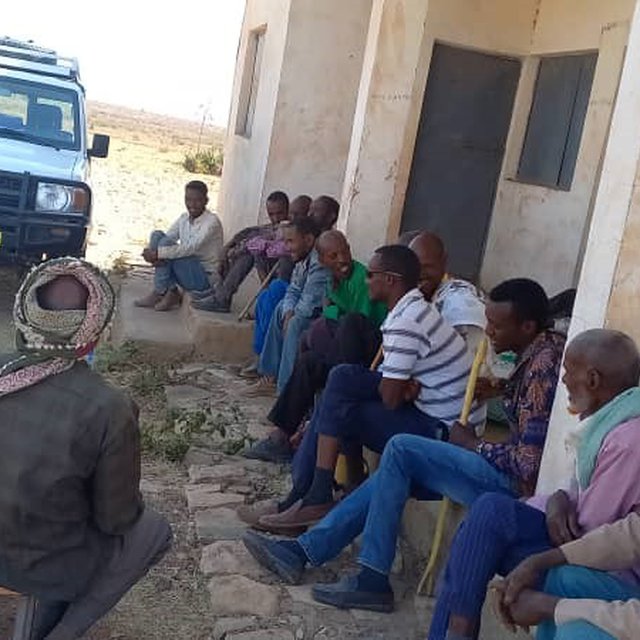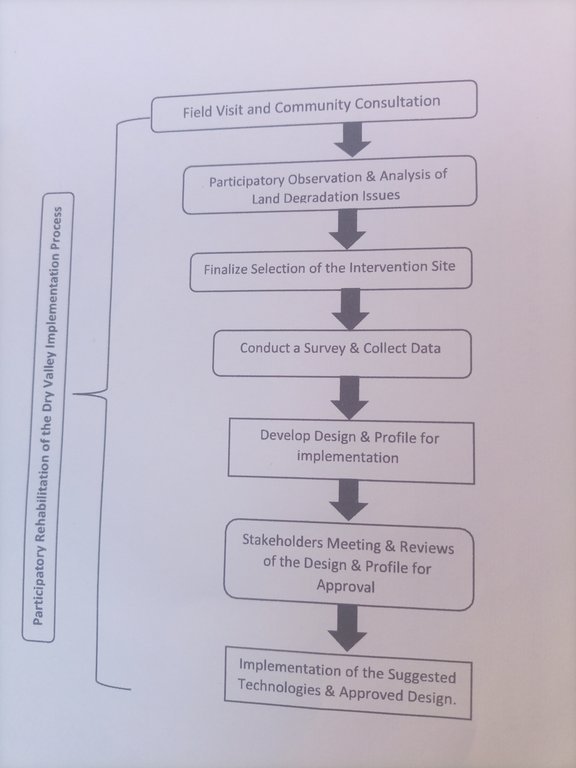Participatory Rehabilitation of Dry Valleys
(Эфиопия)
Kaqayb Galka Dadwayne
Описание
Participatory rehabilitation and productive use of dry valleys is an approach employed to rehabilitate degraded and degradable land. It is operationalised through the Lowland Soil Rehabilitation Project with local development partners from kebele, district, regional agricultural bureaus, and other relevant stakeholders.
Participatory rehabilitation of degraded and degradable dry valleys engages the community at the grassroots through consultation. It is operationalised through the Lowland Soil Rehabilitation Project with local development partners from kebele, district, regional agricultural bureaus, and other relevant stakeholders.
Technical experts from the district and region are involved in reconnaissance, observation and joint selection of the intervention sites. The team conduct a survey, then profile and design the technologies required, along with the project engineer. The approach optimises the participation of the community and agricultural actors, allowing the development of a sense of ownership and accountability through training and awareness-creation exercises. In turn this encourages them to take care of and maintain the structures.
This approach combines top-down and bottom-up methods. At the grassroots, the local agropastoral communities are mobilized by local extension agents and made aware about the SLM intervention that the project and partners strive to put in place – including the physical structures in the farmers' fields and communal lands. The procedures include a site visit, a survey/ observation, and the identification of the intervention site based on the specific topographic features and drainage system of the catchment. Then, detailed field data is collected and a profile analysis is made to develop the design and get approval after stakeholders’ consultation and review of the details of the implementation design. The approach is complemented by satellite imagery and ground truthing. Following this, the next stage is identification of masonry experts, provision of training, and supply of construction materials and tools. Building the masonry works involves both skilled and unskilled labour.
The woreda NRM expert (focal person) facilitate the process at the grassroots through the development agents. The community gives their consent and support to the objectives of the project implementation. Therefore, they are involved in local decision-making and overseeing the technology that is being put in place.
The agropastoral community is the end user and benefits from the positive consequences of the intervention which is a result of better management of soil and water for productive uses of the dry valley. However, because of a lack of awareness, and the agropastoralists conventional livelihoods practice traveling with their livestock, there is a lack of participation in the day-to-day implementation activities. That limits their active contribution in implementation. Of course, local elders value the consultative experience which confirms a sense of self-worth and acknowledges their role in ownership of the land and as the ultimate decision-maker for development intervention operating in their areas.
Местоположение

Местоположение: Amadle kebele, South Jijiga district, Somali, Эфиопия
Географическая привязка выбранных участков
Дата ввода в действие: 2021
Дата завершения: н/п
Тип Подхода
-
традиционная/ местная система землепользования, используемая коренным населением
-
недавняя местная инициатива/ инновация
-
в рамках проекта/ программы

Stakeholder discussion regarding the project implementation and follow-up actions. (Ahmednur Mohamed)
Цели подхода и благоприятные условия для его реализации
Главные цели/ задачи Подхода
To engage the community and other stakeholders in making participatory decisions on the rehabilitation of the dry valley.
Условия, содействующие применению Технологии/ Технологий в рамках Подхода
-
Наличие/ доступность финансовых ресурсов и услуг: Access to finance promotes intensive awareness creation and participation of the community to implement the technology at a larger scale. Also, it allows supporting the maintenance and other follow on actions that ensure sustainability.
-
Институциональные условия: Setting up the local institution such as an agropastoralist group enables the effective implementation of dry valley rehabilitation technologies/practices.
-
Сотрудничество/ координация действий: Coordination of actors enables the identification of useful actors and cross-fertilize experiential knowledge for documentation and further uses. Also, it enables acknowledgment of the contribution of different actors.
-
Осведомленность в области УЗП, доступность технической поддержки: Having SLM knowledge enables efficient and effective implementation of dry valley rehabilitation technologies.
-
Объем работ, доступность рабочей силы: Labour in the agropastoralist area is the limiting factor for the effective implementation of SLM practices. Therefore, the availability of labor or manpower is pivotal for the proper implementation of the SLM.
Условия, затрудняющие применение Технологии/ Технологий в рамках Подхода
Участие и распределение ролей заинтересованных сторон
Заинтересованные стороны, участвующие в реализации Подхода, и их роли
| Какие заинтересованные стороны/ организации-исполнители участвовали в реализации Подхода? |
Перечислите заинтересованные стороны |
Опишите роли заинтересованных сторон |
| местные землепользователи/ местные сообщества |
Agropastoralist. |
Participatory planning and decision making, sources casual laborer and oversee the technologies/practices. |
| эксперты по УЗП/ сельскому хозяйству |
Natural Resource Management experts. |
Facilitate stakeholders' participation, provide technical support, and backstopping services, and monitor the development during and after the implementation of the technologies. |
| частный сектор |
Contractor to perform the engineering works. |
Building/constructing the physical structures. |
| GIZ project |
GIZ (bilateral cooperation) projects. |
Provide financial and technical support to the government partner organizations to promote the proper implementation of the rehabilitation of dry valley. |
Участие местных землепользователей/ местных сообществ на разных стадиях реализации Подхода
нет
пассивное
внешняя поддержка
интерактивное
самоорганизация
инициирование/ мотивация
Agropastoralists involve in allowing peers to understand SLM-related intervention.
планирование
Land users involve in participatory planning and decision-making exercise.
выполнение
Skilled and unskilled laborers are sources from neighboring urban areas and the intervention kebeles.
мониторинг/ оценка
SLM experts and extension agents support in monitoring and evaluation of the intervention activities.
Схема реализации Подхода
The sketch describe the process of implementing Participatory Rehabilitation of Dry Valleys.

Автор: Gerba Leta
Принятие решений по выбору Технологии УЗП
Решения принимались
-
исключительно землепользователи (по собственной инициативе)
-
в основном землепользователи при поддержке специалистов по УЗП
-
все участники как часть процесса совместных действий
-
преимущественно специалисты по УЗП после консультаций с землепользователями
-
исключительно специалисты по УЗП
-
политики/ руководители
Принятие решений было основано на
-
анализ подробно описанного опыта и знаний по УЗП (принятие решений на основе подтвержденных фактов)
-
результаты исследований
-
личный опыт и мнения (незадокументированные)
Техническая поддержка, повышение компетенций и управление знаниями
Следующие мероприятия или работы являлись частью Подхода
-
Повышение компетенций/ обучение
-
Консультационные услуги
-
Институциональная (организационная) поддержка
-
Мониторинг и оценка
-
Научные исследования
Повышение компетенций/ обучение
Обучение было предоставлено следующим заинтересованным лицам
-
землепользователи
-
местный персонал/консультанты
Тип обучения
-
в ходе работы
-
обмен опытом между фермерами
-
опытные участки
-
общие собрания
-
курсы
-
Masonry workers
Рассматриваемые темы
Dry Land Rehabilitation and Produce Use of the rehabilitated land. Basically, the training is on the SLM practices which are suitable for agropastoralist areas with special emphasis on the physical structure.
Консультационные услуги
Консультационные услуги были предоставлены
-
на полях землепользователей
-
в постоянно функционирующих центрах
Advisory services related to SLM are infrequently given. As the agropastoralists are mobile looking for feed and water, particularly during the dry period, advisory services have not been provided on regular basis.
Институциональная поддержка
Какие институциональные структуры были укреплены или вновь созданы
-
нет
-
да, немного
-
да, умеренно
-
да, существенно
на уровне
-
местные
-
региональный
-
национальный
Опишите организацию, функции и ответственность, членство и т.д.
Stakeholders from government and bilateral organization (project) do make ad hoc meeting during planning and evaluation, this brings actors together but need to establish a sustainable institution that stands on its own and can be working beyond the project's lifetime. Particularly, a land users (agropastoralist) group is essential to oversee the technology placed on their land so that sustainability of the intervention can be ensured.
Тип поддержки
-
финансовая
-
повышение компетенций/ обучение
-
оборудование
Подробнее
The equipment refers to the technical tools that can be used by the partner experts - but not farm tools. The latter is expected during which the agropastoralist resumes the productive use of the rehabilitated land which is currently in the initial years of implementation and not yet associated with the productive uses of it.
Мониторинг и оценка
The monitoring and evaluation are part of the project implementation that enables the implementers to track the development and engage the end users to enable them to sense the benefits. The land users started to benefit from the structure such as fetching drinking water both for human and their livestock, though, it is an indirect benefit from the intervention.
Финансирование и внешняя материальная поддержка
Годовой бюджет мероприятий по УЗП в долларах США
-
< 2000
-
2000-10000
-
10000-100000
-
100 000-1 000 000
-
> 1 000 000
Precise annual budget: н/п
No specific data on budget allocation for SLM at the district level. However, Local Subsidy Contract (LSC) was used to assist the woreda implement and follow-up the development of the intervention.
Землепользователям были оказаны/предоставлены следующие услуги или меры стимулирования
-
Финансирование и внешняя материальная поддержка, предоставляемая землепользователям
-
Субсидии на отдельные затраты
-
Кредитование
-
Другие методы или инструменты стимулирования
Анализ влияния и заключительные положения
Влияние Подхода
Нет
Да, немного
Да, умеренно
Да, существенно
Сумел ли Подход расширить возможности местных землепользователей, повысить участие заинтересованных сторон?
Local land users consulted and informed regarding the benefits of SLM for the degraded and potentially degradable lands to ensure rehabilitation and its productive use. This may give motivation and a sense of self-worth as land owner.
Сумел ли Подход дать возможность принимать решения на основе подтвержденных фактов?
Beyond the approach, the land users can learn from the actual function of the technologies.
Сумел ли Подход помочь землепользователям внедрить и поддерживать технологии УЗП?
Consultation with the land users motivates them to build trust in the intervention.
Сумел ли Подход улучшить согласованность действий и повысить рентабельность применения практик УЗП
In the long run, it can assist land users mobilize casual laborers.
Сумел ли Подход мобилизовать/ расширить доступ к финансовым ресурсам для применения практик УЗП?
Сумел ли Подход расширить знания и возможности землепользователей в применении практик УЗП?
The approach creates an opportunity for land users to engage in the initial implementation process through which their awareness is raised.
Сумел ли Подход расширить знания и возможности других заинтересованных сторон?
Through stakeholders meeting and training opportunities created by the project.
Сумел ли Подход укрепить сотрудничество между заинтересоваными сторонами/ выстроить механизмы сотрудничества?
It builds collaboration between stakeholders.
Сумел ли Подход снизить остроту конфликтов?
Сумел ли Подход расширить возможности социально и экономически уязвимых групп?
Involve them in the awareness creation training.
Сумел ли Подход содействать гендерному равенству и расширить права и возможности женщин и девочек?
Women are involved in the community meeting and/or consultation. Also benefited from the technology as it creates the opportunity to fetch drinking still water closer to their residence.
Сумел ли Подход стимулировать молодежь/ будущее поколение землепользователей заниматься УЗП?
It provides knowledge to the young generation through exposure to evidence based intervention.
Сумел ли Подход разрешить правовые проблемы землевладения/ землепользования, препятствующие использованию технологий УЗП?
Сумел ли Подход способствовать улучшению продовольственой безопасности/ качества питания?
The technology implemented using the participatory approach believed to rehabilitate degraded lands and enhances productive use of the rehabilitated lands for growing various crops, and supply feeds to the livestock.
Сумел ли Подход расширить доступ к рынкам?
Сумел ли Подход улучшить санитарные условия и доступ к водоснабжению?
The technology implemented using this approach creates land users temporal access to still as well as groundwater regardless.
Сумел ли Подход привести к более эффективному использованию электроэнергии/ возобновляемых источников энергии?
Сумел ли Подход улучшить способность землепользователей адаптироваться к изменениям климата и смягчать последствия катастрофических погодных явлений?
In the future, when the productive use of dry valley is effected, post the rehabilitation efforts, land users certainly develop an adaptation to climate change and associated disasters through participatory approach.
Сумел ли Подход привести к созданию новых рабочих мест/ к расширению возможностей получения дохода?
It improves generation of income from the production of food and feed crops.
Основные причины, побуждающие землепользователей внедрять УЗП
-
рост продуктивности
-
рост прибыли (доходности) и рентабельности
-
снижение деградации земель
-
снижение риска катастрофических погодных явлений
-
снижение объёма работ
-
материальное стимулирование/ субсидии
-
нормативно-правовое регулирование (штрафы)/ контроль
-
престиж, общественное давление/ солидарность
-
причастность к движению/ проекту/ группе/ сети
-
экологическая сознательность
-
традиции и верования, нравственные ценности
-
приобретение знаний и опыта в области УЗП
-
улучшение эстетической привлекательности
-
снижение остроты конфликтов
Долгосрочная устойчивость мероприятий в рамках Подхода
Могут ли землепользователи самостоятельно (без внешней поддержки) продолжать применение того, что было реализовано в рамках Подхода?
Заключительные положения и извлечённые уроки
Сильные стороны: по мнению землепользователей
-
Creates stakeholders awareness on SLM, and productive use of rehabilitated dry valley.
-
Improves coordination between agricultural actors in line offices, and other stakeholders collective action.
-
Enhances participatory decision making on the development and use of the rehabilitated lands.
Сильные стороны: по мнению составителя или ответственных специалистов
-
It creates evidence based lesson learning to replicate similar practices across the region.
-
It improves SLM implementation capacity of the development partners (agricultural offices) and the land users at local level.
-
It encourages the government respective department to allocate matching fund for SLM operationalized by development partners.
Слабые стороны/ недостатки/ риски: по мнению землепользователейвозможные пути преодоления
-
Time and energy/labor demanding to integrate efforts of experts from different organizations.
Nurture proper joint planning for collective action.
-
Shortage of financial and material resources to put the structure in place.
Find and generate sources of resources and promote efficient use of the available budget.
-
Improper participation of stakeholders (dropout of experts)
Enforce participation through adopting binding by-laws to all.
Слабые стороны/ недостатки/ риски: по мнению составителя или ответственных специалистоввозможные пути преодоления
-
Recurrent droughts displace the land users while looking for water and feed to their animals.
Ensure representation to the community, and assess enabling environment that reduce temporal displacement of the land users.
-
Relatively low participation of the land users in the conception and implementation of the approach as well as the technology intended to rehabilitate the dry valley.
Promote land users participation through intensive capacity building and awareness creation by gender and various categories of the community.
-
Lack of forming agro-pastoralist group who are believed to share knowledge, skills and labor for collective oversee and maintenance of the technology when damage is encountered.
Promote the development of a local institution that allows not only for the use of the land but also to oversee the gaps, report the issues, and involve in participatory fixing activities.
Справочные материалы
Editors
-
Torben Helbig
-
Noel Templer
-
Tabitha Nekesa
-
Ahmadou Gaye
-
Siagbé Golli
Рецензент
-
William Critchley
-
Rima Mekdaschi Studer
-
Sally Bunning
Продолжительность применения Технологии: 23 марта 2023 г.
Последнее обновление: 26 апреля 2024 г.
Ответственные специалисты
-
Ahmed Omer (ahmdomr1954@gmail.com) - Специалист по УЗП
Полное описание в базе данных ВОКАТ
Документирование осуществлялось при участии
Организация
- Alliance Bioversity and International Center for Tropical Agriculture (Alliance Bioversity-CIAT) - Кения
Проект
- Soil protection and rehabilitation for food security (ProSo(i)l)
Ключевые ссылки
-
Problems and landscape approach for ecological rehabilitation in the dry valleys of Southwest China. Dong, Y. & Liu, S. (Undated): https://www.researchgate.net/profile/Shiliang-Liu-5/publication/221354340_Problems_and_Landscape_Approach_for_Ecological_Rehabilitation_in_the_Dry_Valleys_of_Southwest_China/links/574129be08ae9ace84160bec/
Ссылки на материалы по теме, доступные онлайн






